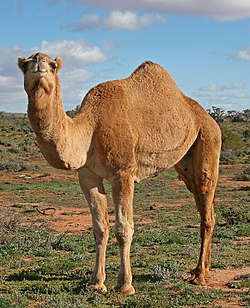核脚亜目
核脚亜目(かっきゃくあもく・かくきゃくあもく、Tylopoda[3])またはラクダ亜目は偶蹄目(または鯨偶蹄目)の一系統群である。始新世(5,000万年前)に誕生し、北アメリカとユーラシアに分布を広げた。現生種は全てラクダ科に属し、ラクダ、リャマ、グアナコ、ビクーニャ、アルパカなどが属す。かつては現在より多様で、多くの絶滅科や絶滅したラクダ科の種がいる。反芻類ではない[4]。
| 核脚亜目 | |||||||||||||||||||||
|---|---|---|---|---|---|---|---|---|---|---|---|---|---|---|---|---|---|---|---|---|---|

| |||||||||||||||||||||
| 地質時代 | |||||||||||||||||||||
| 始新世 - 完新世 | |||||||||||||||||||||
| 分類 | |||||||||||||||||||||
| |||||||||||||||||||||
| 学名 | |||||||||||||||||||||
| Tylopoda Illiger, 1811 | |||||||||||||||||||||
| 和名 | |||||||||||||||||||||
| 核脚亜目[1] ラクダ亜目[2] |
系統と分類
編集核脚類(Tylopoda)はIlliger (1811) によって提唱され、Matthew (1908) によって反芻類(Ruminantia)に分類された[5][6][7]。以降はSinpson(1945) のように偶蹄目内の核脚亜目に位置付ける説が主流であったが、Romer (1966) のように反芻亜目の下位グループとする説も対立していた[8]。
核脚類を取り巻く現状に関する問題としては、ラクダ様の哺乳類の広範な化石記録が、分岐学的観点からまだ完全に調査されていないことである。核脚類は偶蹄類の中で非常に特徴的な系統群であるものの、現生6種はすべてが非常に近縁で、古くに放散して反映した核脚類の複数の系統群のうち唯一生き残った系統群(いわば「生きた化石」)であるため、核脚類全体の正確な系統関係を把握するのが難しい。最近の研究では、核脚類が伝統的に考えられていたほど反芻類と近縁ではないことが示されており、偶蹄類内での系統的位置は以下となっている[9][10][11][12][13][14]。
| 偶蹄目 |
| ||||||||||||||||||||||||
| Artiodactyla |
核脚類の進化は保守的で、4,000万年以上反芻類と同じニッチを占めてきたようである。従って反芻類と核脚類は形態も似ているように見えた理由は、系統的に近いからではなく、偶蹄類の他のグループ(クジラ類やイノシシ類など)が適応放散して形態を多様化させたからである。しかし核脚類が偶蹄類の中で基盤的位置にあることから、核脚類の古いメンバーは形態的に祖先的であり、他の偶蹄類の系統群と区別が付きにくいことを意味している。この問題についての最初の主要な現代的かつ包括的な分析 (Spaulding et al., 2009) は、これを支持している。 いくつかの分類群は伝統的にこの亜目に属していると考えられてきたが(そのうちいくつかは反論されているが)、このグループを取り巻く状況は、その広範な化石記録にもかかわらず(またはそのために)、依然として大きな議論となっている[9]。
現在(ある程度の信頼性をもって)核脚亜目に分類されているグループは以下のとおり[9]。和名は遠藤・佐々木(2001) および冨田(2011) に従う[15][16]。
- 基盤的またはincertae sedis
- †Gobiohyus属?
- †Homacodontidae科
- †アノプロテリウム上科 Anoplotherioidea
- †アノプロテリウム科 Anoplotheriidae
- †カイノテリウム科 Cainotheriidae – カイノテリウム属など
- †Dacrytheriidae科
- ラクダ上科 Cameloidea
- †オロメリクス科 Oromerycidae
- ラクダ科 Camelidae – ラクダ属、リャマ属、ビクーニャ属、ティタノティロープス属、アエピカメルス属など
- †メリコイドドン上科 Merycoidodontoidea (=Oreodontoidea)
- †アグリオコエルス科 Agriochoeridae (側系統)
- †メリコイドドン科 Merycoidodontidae
- †Xiphodontoidea上科
所属に議論があるもの
編集以下の偶蹄目の系統群は、時には核脚亜目に分類されることがあるが、偶蹄類の中でのincertae sedisまたは基盤系統と見る研究者もいる。
- †Antiacodontidae科
- †ケボコエルス科 Cebochoeridae
- †コエロポタムス科 Choeropotamidae科 (=ハプロブノドン科 Haplobunodontidae)
- †Diacodexeidae科 (側系統)
- †レプトコエルス科 Leptochoeridae
一方で、Cebochoeridae科とプロトケラス科(Protoceratidae)は、かつてはよく核脚亜目に含まれたが、現在は反芻類に最も近縁と考えられている[要出典]。
脚注
編集- ^ 日本哺乳類学会 種名・標本検討委員会 目名問題検討作業部会 「哺乳類の高次分類群および分類階級の日本語名称の提案について」『哺乳類科学』第43巻 2号、日本哺乳類学会、2003年、127-134頁。
- ^ 三浦慎悟「有蹄類にみられる順位と社会構造」『哺乳類科学』第27巻 1・2号、日本哺乳類学会、1987年、5-26頁。
- ^ Donnegan, James (1834). "A New Greek and English Lexicon"
- ^ Fowler, M.E. (2011). "Medicine and Surgery of Camelids", Ames, Iowa: Wiley-Blackwell. Chapter 1, General Biology and Evolution, addresses the fact that camelids (including llamas and camels) are not ruminants, pseudoruminants, or modified ruminants.
- ^ Matthew, W. D. (1908). “Osteology of Blastomeryx; and phylogeny of the American Cervidae”. Bulletin of the American Museum of Natural History 24 (27): 535–562. hdl:2246/1442.
- ^ Carroll, Robert L (1988). Vertebrate paleontology and evolution. Freeman
- ^ Ursing, B. M.; Slack, K. E.; Arnason, U. (April 2000). “Subordinal artiodactyl relationships in the light of phylogenetic analysis of 12 mitochondrial protein-coding genes”. Zoologica Scripta 29 (2): 83–88. doi:10.1046/j.1463-6409.2000.00037.x.
- ^ 大泰司紀之「偶蹄目の進化」『哺乳類科学』第10巻 2号、日本哺乳類学会、1970年、155-168頁。
- ^ a b c Spaulding, M., O'Leary, M.A. & Gatesy, J. (2009): "Relationships of Cetacea (Artiodactyla) Among Mammals: Increased Taxon Sampling Alters Interpretations of Key Fossils and Character Evolution". PLoS ONE no 4(9): e7062. doi:10.1371/journal.pone.0007062.
- ^ Beck, N.R. (2006). “A higher-level MRP supertree of placental mammals”. BMC Evol Biol 6: 93. doi:10.1186/1471-2148-6-93. PMC 1654192. PMID 17101039.
- ^ O'Leary, M.A.; Bloch, J.I.; Flynn, J.J.; Gaudin, T.J.; Giallombardo, A.; Giannini, N.P.; Goldberg, S.L.; Kraatz, B.P. et al. (2013). “The Placental Mammal Ancestor and the Post-K-Pg Radiation of Placentals”. Science 339 (6120): 662–667. Bibcode: 2013Sci...339..662O. doi:10.1126/science.1229237. hdl:11336/7302. PMID 23393258.
- ^ Song, S.; Liu, L.; Edwards, S.V.; Wu, S. (2012). “Resolving conflict in eutherian mammal phylogeny using phylogenomics and the multispecies coalescent model”. Proceedings of the National Academy of Sciences 109 (37): 14942–14947. Bibcode: 2012PNAS..10914942S. doi:10.1073/pnas.1211733109. PMC 3443116. PMID 22930817.
- ^ dos Reis, M.; Inoue, J.; Hasegawa, M.; Asher, R.J.; Donoghue, P.C.J.; Yang, Z. (2012). “Phylogenomic datasets provide both precision and accuracy in estimating the timescale of placental mammal phylogeny”. Proceedings of the Royal Society B: Biological Sciences 279 (1742): 3491–3500. doi:10.1098/rspb.2012.0683. PMC 3396900. PMID 22628470.
- ^ Upham, N.S.; Esselstyn, J.A.; Jetz, W. (2019). “Inferring the mammal tree: Species-level sets of phylogenies for questions in ecology, evolution, and conservation”. PLOS Biology 17 (12): e3000494. doi:10.1371/journal.pbio.3000494. PMC 6892540. PMID 31800571.(see e.g. Fig S10)
- ^ 遠藤秀紀, 佐々木基樹「哺乳類分類における高次群の和名について」『日本野生動物医学会誌』第6巻第2号、2001年、45-53頁、doi:10.5686/jjzwm.6.45。
- ^ 冨田幸光, 伊藤丙雄, 岡本泰子イラスト「冨田幸光「偶蹄類」」『絶滅哺乳類図鑑』(新版)丸善、182-211頁。ISBN 9784621082904。全国書誌番号:21894977。
参考文献
編集- Simpson, George Gaylord (1945). The principles of classification and a classification of mammals. 85. American Museum of Natural History